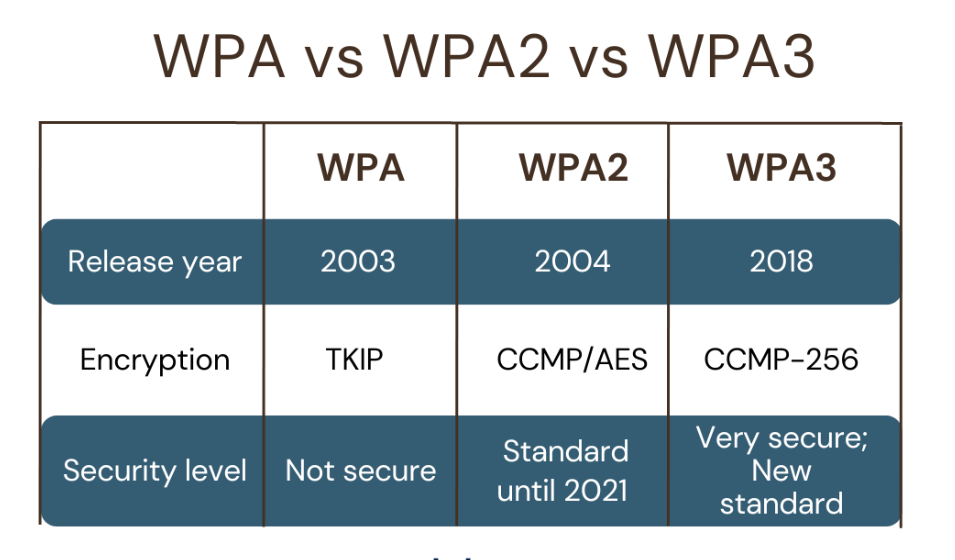Understanding WPA2 and WPA3 for Maximum Wi-Fi Security
In an era where cyber threats are constantly evolving, securing your Wi-Fi network is more critical than ever. Many users wonder what is WPA2/WPA3 personal password characters examples and how to create a strong passphrase to prevent unauthorized access. This guide will break down WPA, WPA2, and WPA3 security protocols, discuss password requirements, and offer best practices for enhancing network security.
Understanding WPA, WPA2, and WPA3 Security Protocols
Wi-Fi Protected Access (WPA) is a security protocol developed to secure wireless networks. Over the years, it has evolved into WPA2 and the latest WPA3, each offering improved encryption and security features to prevent unauthorized access and protect against cyber threats.
- WPA (Wi-Fi Protected Access): Introduced to replace the vulnerable WEP (Wired Equivalent Privacy), WPA uses Temporal Key Integrity Protocol (TKIP) to enhance security. TKIP dynamically generates a new encryption key for each data packet, making it harder for attackers to intercept data.
- WPA2: A significant upgrade over WPA, WPA2 utilizes the Advanced Encryption Standard (AES) and supports WPA2-PSK (Pre-Shared Key) authentication for personal networks. AES is a robust encryption algorithm widely used in network security to ensure data confidentiality.
- WPA3: The latest and most secure version, WPA3 replaces WPA2-PSK with Simultaneous Authentication of Equals (SAE), which provides better protection against offline dictionary attacks. It also enhances security for IoT devices and public Wi-Fi networks by implementing Wi-Fi Easy Connect and Cipher Block Chaining Message Authentication Code Protocol (CCMP).
WPA2 vs. WPA3: Which Offers the Best Wi-Fi Security?
Both WPA2 and WPA3 provide strong network security, but WPA3 offers additional enhancements:
- Stronger encryption: WPA3 replaces WPA2-PSK with SAE, reducing vulnerability to brute-force attacks.
- Improved security for IoT devices: Many smart home devices rely on Wi-Fi, making WPA3’s improved encryption key management essential for secure connectivity.
- Better protection for public Wi-Fi networks: WPA3 uses Wi-Fi Easy Connect, allowing seamless and secure authentication without requiring complex passwords.
- Protection against offline dictionary attacks: WPA3’s SAE protocol ensures that even if an attacker intercepts a Wi-Fi handshake, they cannot use offline attacks to crack the password.
WPA2 and WPA3 Password Requirements
A strong password is crucial for securing your wireless network. Here are the minimum requirements:
- WPA2 Password Length Minimum: At least 8 characters, but 12-16 characters is recommended for better security.
- WPA3 Password Length: While WPA3 does not require longer passwords, using at least 12-16 characters with a mix of letters, numbers, and symbols strengthens security.
- Encryption Key Strength: Both WPA2 and WPA3 utilize 128-bit or 256-bit encryption keys for added protection.
What Are WPA2/WPA3 Personal Password Characters Examples?
A strong WPA2 or WPA3 password should be complex and difficult to guess. Below are examples of strong passwords:
Strong Password Examples:
- Zy$!t9@pHcLq
- M@xSecur3WiFi#
- H0m3_N3tw0rk99!
These passwords incorporate uppercase and lowercase letters, numbers, and special characters to create a secure Wi-Fi passphrase.
Wi-Fi Network Security Best Practices
To ensure the highest level of protection for your wireless network, follow these best practices:
- Enable WPA3 Security Protocol: If your router supports WPA3, enable it for maximum security.
- Use a Strong Wi-Fi Password: Avoid common words, dictionary words, or predictable phrases. Instead, use a mix of letters, numbers, and symbols.
- Activate AES Encryption: Ensure that AES encryption is enabled to prevent unauthorized access to your network.
- Disable Wi-Fi Protected Setup (WPS): WPS is vulnerable to brute-force attacks and should be turned off.
- Update Router Firmware Regularly: Keeping your router’s firmware updated ensures that the latest security patches are applied.
- Use a Guest Network for Visitors: Creating a separate Wi-Fi network for guests prevents them from accessing sensitive devices on your primary network.
- Enable MAC Address Filtering: Restrict network access by allowing only specific device MAC addresses to connect.
- Use QR Codes for Wi-Fi Sharing: Instead of sharing passwords manually, generate a QR code that allows trusted users to connect securely.
- Monitor Connected Devices: Regularly check for unknown devices on your Wi-Fi network to detect unauthorized access.
- Enable Network Encryption and Firewall: A firewall adds a layer of security by blocking malicious traffic.
WPA2-PSK vs. WPA3 Security Features
While WPA2-PSK (Pre-Shared Key) authentication remains widely used, it has some vulnerabilities compared to WPA3:
- Key Exchange Method: WPA3 uses SAE for more secure key exchange, preventing offline dictionary attacks.
- Encryption Algorithm: WPA2 relies on AES-CCMP, whereas WPA3 strengthens encryption with GCMP-256 (Galois/Counter Mode Protocol).
- Authentication of Equals (SAE): Unlike WPA2, WPA3 eliminates the risk of passphrase interception during handshake authentication.
How to Secure IoT Devices on a Wi-Fi Network
IoT devices, such as smart thermostats, security cameras, and home automation systems, often have weaker security protections. Here’s how to protect them:
- Use a Separate IoT Network: Many routers allow users to create a secondary Wi-Fi network specifically for IoT devices.
- Disable Unnecessary Features: Turn off remote access and UPnP (Universal Plug and Play) if not needed.
- Regularly Update Firmware: Keep IoT device firmware up-to-date to patch security vulnerabilities.
- Enable Two-Factor Authentication (2FA): If available, enable 2FA for additional security.
How WPA3 Protects Against Offline Dictionary Attacks
One of the biggest security improvements in WPA3 is protection against offline dictionary attacks. Traditional Wi-Fi networks using WPA2-PSK are vulnerable to attackers capturing Wi-Fi handshakes and running brute-force attacks offline. WPA3’s Simultaneous Authentication of Equals (SAE) prevents this by using forward secrecy, ensuring that intercepted data cannot be decrypted later.
Conclusion: Strengthen Your Wi-Fi Security Today
Understanding WPA2 and WPA3 security protocols is essential for safeguarding your wireless network. Whether you’re using WPA2 or upgrading to WPA3, following best security practices, using a strong password, and enabling advanced encryption methods will help keep your home network secure. By implementing these strategies, you can protect against cyber threats, unauthorized access, and offline dictionary attacks, ensuring the safety of your personal and IoT devices. Secure your Wi-Fi network today and stay ahead of evolving security risks!
